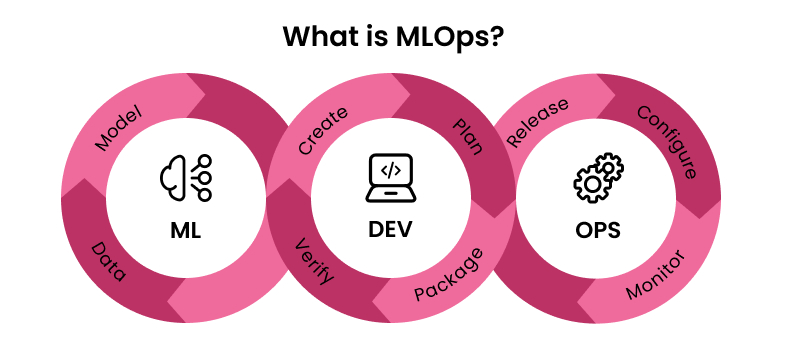When looking into ways to develop a machine learning model, you might encounter articles promoting machine learning operations (MLOps).
And while it’s true that adopting it into your workflow will be beneficial, materials on the internet rarely cover possible issues you might face on your way to success. Today, we will talk about MLOps challenges you might encounter and, of course, how to solve them.
What is MLOps?
Machine learning operations (MLOps) is a paradigm of development, deployment, monitoring, and management of machine learning (ML) models in production environments.
The main goal of MLOps is optimization and standardization, which will help bridge the gap between data scientists and developers. This is achieved by applying principles and practices from development operations (DevOps) to machine learning workflows.

Just like DevOps, MLOps has several principles, and you’ll find the main ones below.
Reproducibility and Versioning. The core feature of any ML project is being able to reproduce results. A good way to ensure reproducibility is to version the code you use. Tracking changes with a version control system should be a central focus of any development.
Monitoring. While most people might think that monitoring is a final step of MLOps, it’s not. Monitoring should be implemented as soon as possible before your model gets deployed into production. This will help you gather insights about data trends and model behavior. The sooner you will start monitoring, the more significant insights you will get.
Benefits of MLOps: Realizing the Advantages of Automated ML Operations
Read more
Testing. You probably know that testing originates from software engineering. But how does it relate to machine learning models? There are several things you need to always keep validated, such as quantity and quality of input data, compliance with your features and data pipelines, etc. It will make your machine learning workflows more robust and resilient.
Automation. This is a crucial aspect of MLOps. The level of automation determines ML process maturity, which, in turn, increases the velocity for model training. Ideally, you want to automate every ML workflow step without any manual intervention.
By using MLOps, you secure yourself a reliable, scalable, secure, and, most importantly, cost-efficient machine learning model.
Understanding the Importance of MLOps
To understand the importance of MLOps, we need to look into its benefits. Here are some of them:
Reproducibility. MLOps allows developers to reproduce ML model results. This encourages experimentation without worrying about losing progress.
Version Control. One of the most useful features MLOps borrowed from traditional software development (more specifically, DevOps) is version control. It allows improved management of a machine learning model and makes it easier to track changes from one version to another.
Cross-Functional Collaboration. Developers who worked on ML models know how important collaboration between different departments is. MLOps encourages this collaboration by providing a common platform to align goals between the departments and strengthen communication.

Automated Pipelines. One of the most common errors that occur and easily go unnoticed long-term is human error. By automating more processes, you eliminate the possibility of such errors to take place. On top of that, it speeds up the development process.
Scalability. Scaling is a “Great Filter” for ML models, as the ability to operate with large datasets defines ML usefulness. MLOps practices are here to help you with that.
Continuous Deployment. Reaching ML model endpoints doesn’t stop development or deployment. As soon as real data hits the model, it is expected to see bugs or inefficiencies. Fortunately, MLOps allows for quick iterations and updates.
Model Monitoring. This is the best way to gather insights about machine learning model development. The sooner you’ll start monitoring, the more value you’ll gain over time. On top of that, MLOps involves monitoring solutions to detect potential data drift. This ensures model accuracy and reliability over time.
Model Maintenance. Usually, model maintenance is a tedious process that ties up the hands of model engineers. MLOps not only allows them to automate maintenance but also offers strategies for model retraining.
Regulatory Compliance. If you need machine learning models to comply with industry-specific regulatory requirements, MLOps frameworks can address it. They provide a mechanism for tracking and auditing model behavior and decisions.
Resource Optimization. MLOps helps optimize resource utilization by efficiently managing machine learning models’ computational resources and minimizing unnecessary expenses.
Risk Management. Implementing robust testing, validation, and quality assurance processes, MLOps reduces the risk of deploying inaccurate or biased models in production environments.
To summarize, MLOps is very beneficial over the whole machine learning lifecycle. By combining the principles of DevOps with data science, it aims to streamline the end-to-end process of deployment.
Still, despite all of the benefits, it’s not entirely perfect. Let’s talk about MLOps challenges.
Principal MLOps Challenges and Ways to Overcome Them

When adopting MLOps into your workflow, there are two key aspects to consider.
On the one hand, MLOps techniques evolve fast, introducing innovations every day. On the other hand, it is a fairly new practice, and you might face some MLOps challenges along the way. Let’s cover the most common ones.
1. Insufficient Data Science Expertise
While the position of data scientists in organizations isn’t something new, that doesn’t mean there are a lot of employees with the required expertise. The main reason behind this problem is enterprise corporations. They invest in talent acquisition, which leads to a lack of talent on the market for startups and mid-size businesses.
The lack of skilled employees for the data science department and constant attrition may influence the ML production cycle. Mitigating this challenge might seem difficult due to its competitive nature, but there is a way.
What can you do?
One of the options you have is hiring remotely. This gives you access to a more skilled pool of potential employees effectively creating a data science team for you. Alternatively, you can hire a young talent with the intent of developing their skills in your company.
Another option is to reach out to service provider companies. Depending on your level of commitment, they can provide MLOps consulting, develop a proof of concept, or create machine learning models of your desire.
If you choose option B and are currently looking for a skilled service provider, contact the CHI team now, and we will reach out to you within several business hours.
Exploring MLOps Use Cases: 8 Real-World Examples and Applications
Read more
2. Unrealistic Expectations
Most MLOps challenges are about current limitations or flaws in company structures. But this one is about what businesses expect to get in the future.
Artificial intelligence is a great tool that can help you optimize your business and bring you more profits. However, it’s not a magic solution to all of your challenges.
If you are not an expert technician, there might be a chance that you are holding unrealistic expectations of what AI can do. This challenge is common among lots of companies. Usually, it happens as a result of not understanding what AI is and how it will affect your business.
What can you do?
To overcome this challenge, you need a person with technical expertise. Consulting with tech department leaders is crucial for understanding what AI can bring to the table and what your team can do with the resources you have on the table. And yes, our team can help with this too.
3. Data Management and Quality Assurance Issues

Data-related challenges are an inevitable part of ML model development, and most of them fall into one of two categories. What are they, and what can you do?
- Data discrepancies: Data often needs to be sourced from multiple places, which leads to a mismatch in data formats and values. For limiting data discrepancies, look into centralizing your data storage and standardizing mappings across teams that use it.
- Lack of data versioning: Data keeps evolving, which can affect model performance. As a solution, modify pre-existing data dumps or create new data versions. A good call would be to do model versioning too.
You need to remember that data preparation is a crucial step and data quality will affect the model performance of your machine learning models. This is a very sensitive step and it is highly advised to conduct regular sanity checks on data quality and data access points.
4. Model Deployment and Monitoring Challenges
Deployment is the moment when machine learning models are already developed and ready to be shipped to end users. And yet, even at this point, some challenges await you.
Development and production teams usually start collaborating only at the deployment phase. This makes the one-time deployment process faulty and inefficient.
What can you do?
To solve this problem, consider deploying your machine learning models iteratively. This approach reduces the need for reworks and general friction between departments. Ideally, you want to set up different solution modules step-by-step and update them during one sprint.
5. Insufficient Resources and Infrastructure

Any machine learning solution is based on research done by data scientists. To make it as optimal as possible, you need to encourage experimentation across all development stages.
However, running multiple experiments simultaneously may be chaotic and cost-heavy for company resources. Different data versions and processes need beefy hardware.
Another problem you may encounter is a lack of proper documentation around model research and development on the developer’s side.
What can you do?
If you’re dealing with a hardware problem, look into virtual hardware from third parties. If lack of documentation is the problem you’ve encountered, promote performing experiments on scripts since it’s much more efficient and less time-consuming.
6. Collaboration and Communication Hurdles in MLOps Teams
MLOps makes a necessity out of cooperation between different teams. Data scientists, data engineers, and developers need to work together in close collaboration. But that’s where things may not go as planned.
Not all businesses are accustomed to operating in this manner. This can be the biggest obstacle for many companies aiming to become data-driven.
What can you do?
To combat this problem, you need to explain a culture of collaboration to stakeholders. Once they understand the link between department cooperation and model performance (along with business KPIs), they will see collaboration as a necessity. This will make the model validation process much more productive.
7. Insufficient Scaling Toolkit

In recent years, many organizations shifted from experimenting with AI to actively implementing it into enterprise applications. While it confirms commitment to AI projects, it also raises the questions about scalability of ML solutions.
What can you do?
This problem is easily mitigated with the right workflow and tools for deployment and monitoring production. End-to-end MLOps platforms address multiple needs related to automation, monitoring, alerting, integration, and deployment.
8. Security
ML models often operate with highly sensitive data. Without ensuring a safe environment, your data might be considered a public domain. One of the most common safety breaches in the environment is done through outdated libraries. Often, users are not aware of library vulnerabilities, and they become prime targets for malicious attacks.
Another big security hole is related to data pipelines. Sometimes, they are publicly accessible, which leads to the exposure of data collection to third parties.
What can you do?
There is no such thing as perfect data security. However, you can protect yourself from the most common causes of data leakage by adopting software that offers security patching.
It is also a good choice to follow basic security hygiene: use secure, scalable data storage and establish clear data access protocols and encryption standards.
Tools that offer multi-tenancy are also a good choice. They protect the internal environment, elevating data security, and the safety of different initiatives that could be sensitive to the public.
9. Suboptimal Framework

The software framework that companies use for deployment is often suboptimal or irrelevant for deploying ML solutions.
Such an issue can double the work for development and deployment teams when complying with the framework’s requirements. This takes a lot of time and could lead to resource optimization issues.
Moreover, once engineers figure out how to overcome the framework, they will have to repeat the suboptimal process to deploy every solution they want.
What can you do?
There are two ways to fix this problem. The first one involves investing in creating a separate ML stack integrated into the company framework. The second one is to use virtual environments. They provide the ability to develop and deploy your ML model without the use of your computing powers.
AI Matchmaking: Choosing the Right AI Expertise for Your Business Goals
Click to read
10. High Costs
Out of all MLOps challenges, this one is the most overseen. MLOps initiatives need a significant time and money investment to be successful. So, it’s better to evaluate your capacity before MLOps activities start.
It is common to see development teams work in suboptimal conditions since resources with better computational power are out of the company’s budget.
What can you do?
Generally, quality costs money. However, data science teams need to look at the business side and do a detailed cost-benefit analysis. This analysis and your business perspective (short-term or long-term profit orientation) will help define a common vision for all departments.
Conclusion
While MLOps challenges are hard to overcome for some companies, it remains the most preferred way to develop ML models. We have covered the most common ones you might encounter during your development process and how to mitigate them.
If ML model development is too challenging for you, but you still want to make a switch to become a data-driven company, you need a great service provider.
We at CHI Software can provide you with MLOps consulting and other machine learning and AI services. Your AI journey starts with one contact form. Here it is. See you in a few days!
About the author
Alex Shatalov
Data Scientist & ML Engineer
Alex is a Data Scientist & ML Engineer with an NLP specialization. He is passionate about AI-related technologies, fond of science, and participated in many international scientific conferences.









